"As regards the island of Dokdo, otherwise known as Takeshima or Liancourt Rocks, this normally uninhabited rock formation was according to our information never treated as part of Korea and, since about 1905, has been under the jurisdiciton of the Oki Islands Branch of Shimane Prefecture of Japan. The island does not appear ever before to have been claimed by Korea...."Some Koreans and Dokdo advocates claim that the US government changed her mind on the status of Liancourt Rocks with the signing of the 1952 treaty between Japan and the US, but the following 1953 letter reconfirms that the US government still considered Liancourt Rocks to be Japanese even after the signing of the treaty. The 1954 Van Fleet report, HERE, also reconfirmed the US position. (For a Japanese explanation of the letter below, see HERE)
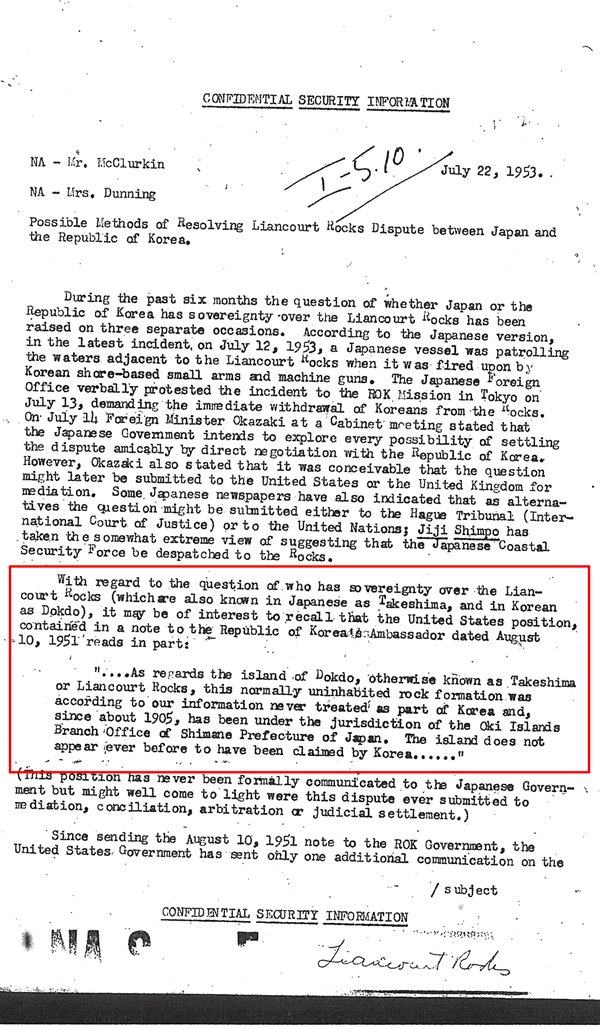
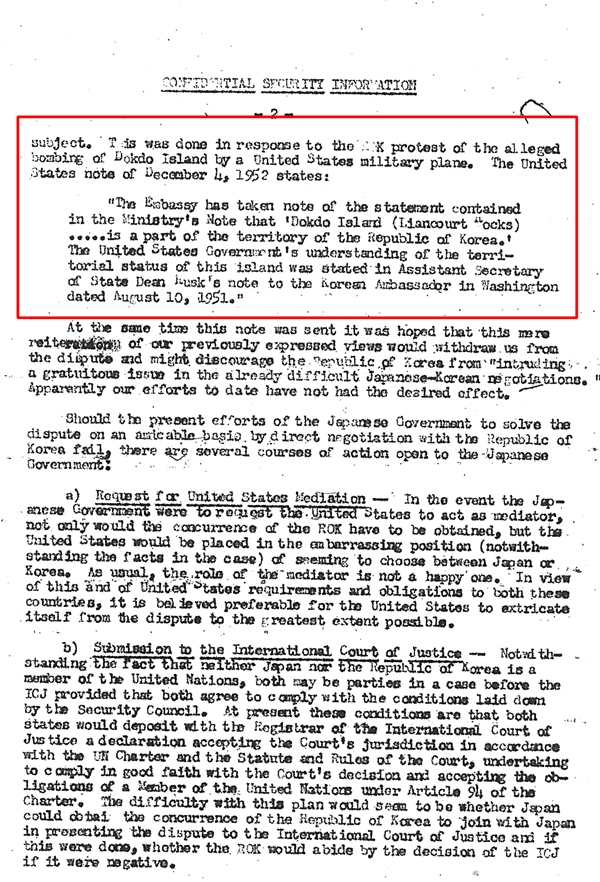
August 9, 1951 Dean Rusk Letter to Korean Ambassador
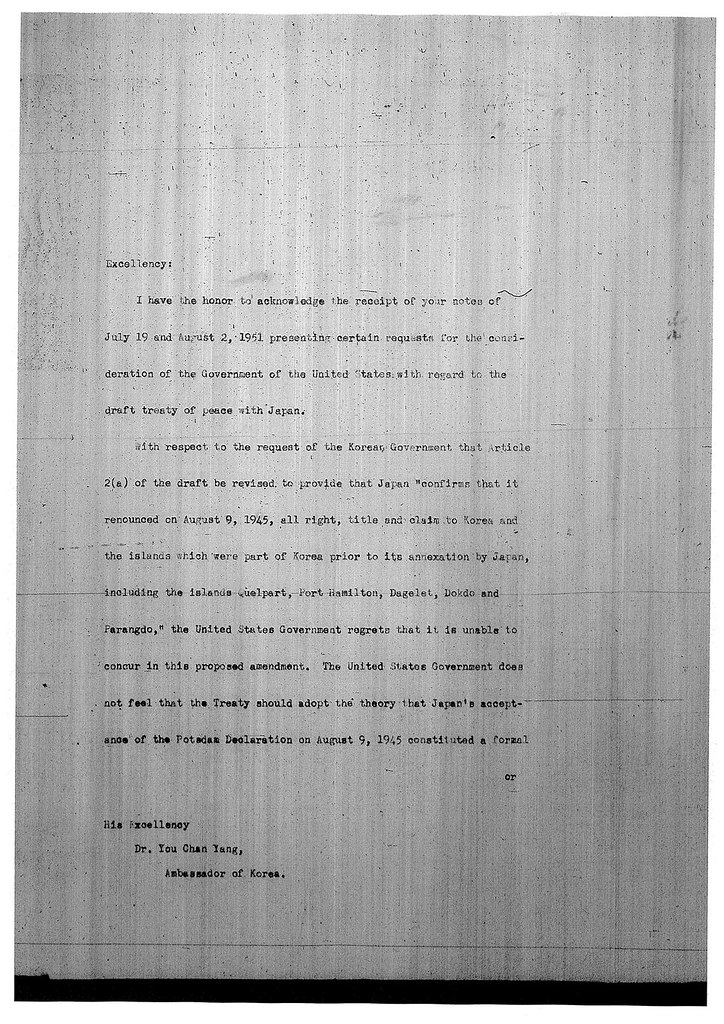

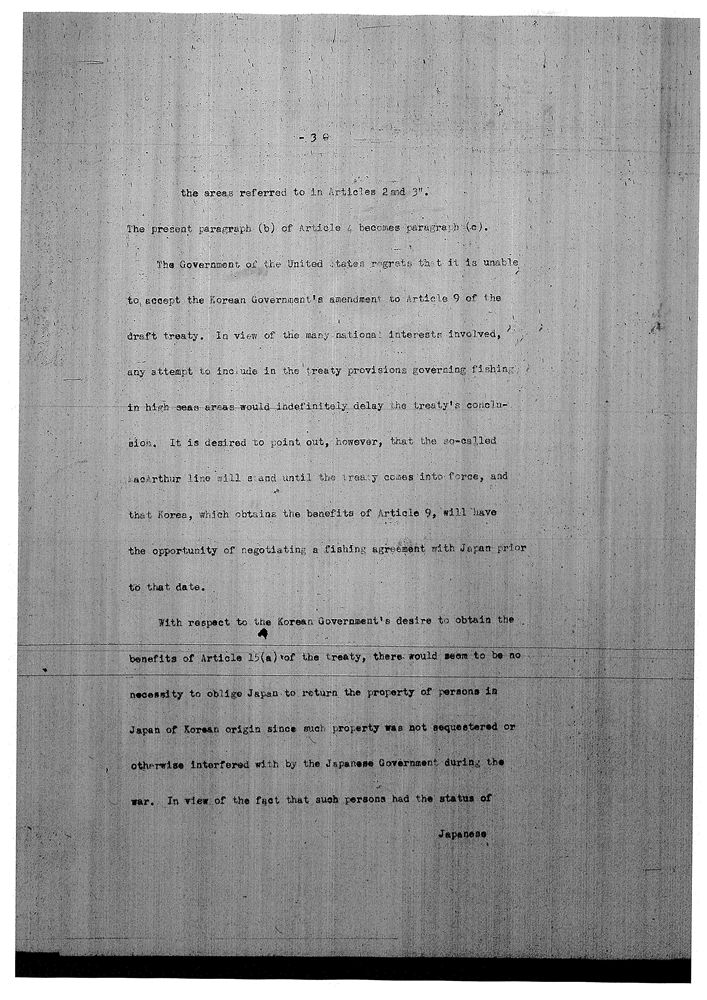
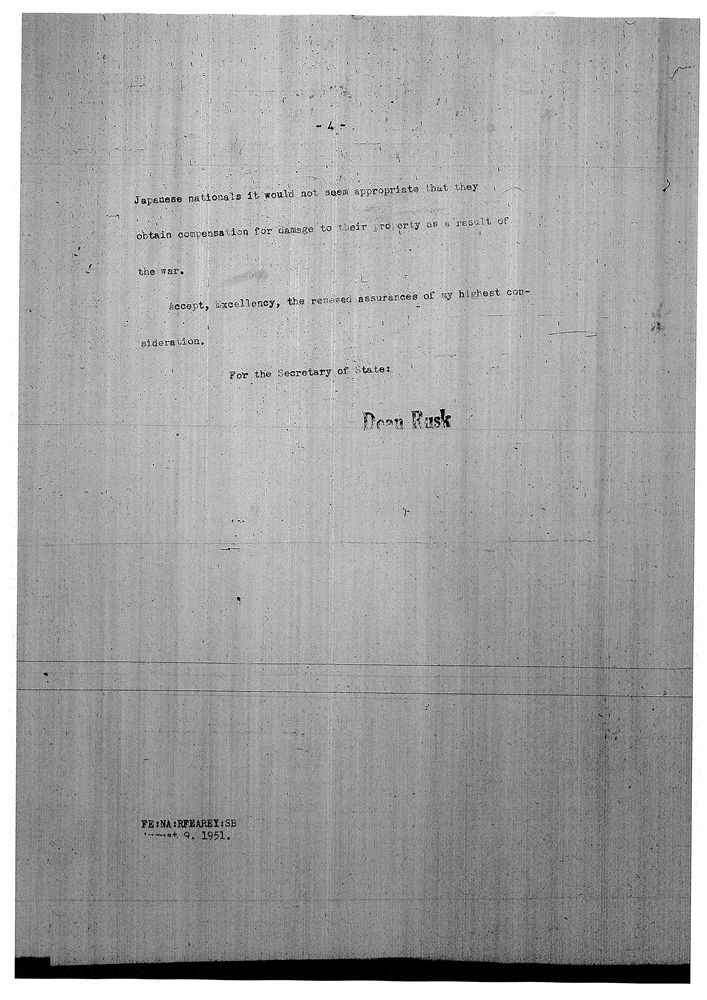
The Rusks docs are old news.
ReplyDeleteThere are several problems with the Rusk letters.
First, they are a confidential memorandum and not one syllable of them ever made the sacred pages of the San Francisco Peace Treaty. The was no mention of Liancourt Rocks in the SF Treaty.
Second, there were well over 40 nations that signed the treaty and America was just one. These papers at best represent only U.S. opinion at one point in time during the process.
As Mr Van Dyke said in his article.
The negotiations involving the fate of former Japanese territories was a long, drawn-out process. The first five and seventh drafts of the treaty provided that Liancourt be given to Korea by including the islets in the Article 2(a) list. The sixth, eighth, ninth, and fourteenth drafts explicitly stated that the territory of Japan included Dokdo Takeshima. The tenth through thirteenth and fifteenth through eighteenth drafts, like the final draft, were silent on the status of Dokdo Takeshima.
In the end there was no mention of Liancourt Rocks in the San Francisco Peace Treaty. The allied powers did not indicate why they chose to remain silent on the outcome, but the varying positions taken during the deliberation process indicate that the decision was made either because not enough information had bee provided regarding the historical events surrounding Japan's incorporation of Dokdo Takeshima or because the Allied Powers felt themselves incapable or inadequate adjudicators.
Third, allied decisions on territories made during this era were based more on military posturing that a true determination of sovereignty based on historical research. A couple of confidential memorandums show us the decision process involved during the San Francisco Peace Treaty.
The first document was a conversation were the allies considered giving Chejudo to Japan because they were concerned about communist forces taking over the entire Korean peninsula. There was never any doubt Chejudo was part of Korea but still the allies mulled over the idea of giving the island to Japan.
Allied Policy2
The conversation reads as follows: The document states, "Sir Dening remarked that the Island of Quelpart (Chejudo) which Japan was to renounce as being part of Korea might become a military liability. Quelpart was very near Japan, and Korea might turn communist. After some discussion Colonel Bab cock said that he thought that if the whole of Korea became a communist state the position would have changed so much for the worst that the question of whether or not Quelpart was part of Korea would not make much difference from the military point of view. It was agreed however this would be considered further..."
The second document written by First Secretary of the America Embassy in Tokyo Mr Steeves shows that although the American’s believed that Takeshima was part of the Korean Kingdom they still designated the island a military facility of the Japanese Government.
Allied Policy 2
The Cold War started America and her allies were in the process of militarily posturing against Russian and China. Staunch anti-communist politicians such as Dean Rusk were involved in the negotiations over Takeshima. It is Dean Rusk's confidential memorandums that Japan cites in their argument over Takeshima. Who was Dean Rusk?
Dean Rusk was involved in military affairs throughout his life and political career. In World War II he joined the infantry as a reserve captain (he had been a ROTC Cadet Lieutenant Colonel), he served in Burma as a staff officer and ended the war as a colonel with the Legion of Merit and Oak Leaf Cluster. He returned to America to work briefly for the War Department in Washington
He was made Assistant Secretary of State for Far Eastern Affairs in 1950 and played an influential part in the US decision to become involved in the Korean War. As Secretary of State he was consistently hawkish, a believer in the use of military action to combat Communism. During the Cuban missile crisis he initially supported an immediate military strike, but he soon turned towards diplomatic efforts. His public defense of US actions in the Vietnam War made him a frequent target of anti-war protests. It's not an exaggeration to say Dean Rusk's military background deeply effected his political decisions and his policy on Takeshima was no exception. American policy on Takeshima was just a reflection of her military policy in Northeast Asia during the Korean/Cold War.
When the South Koreans allowed the Yanks to maintain an armed “footprint” on the Asian mainland, the U.S. dropped support for Japan. America played Japan and Korea.
Haven’t any of you guys ever dated two girls at the same time before?
Here's the confidential memorandum on Cheju again.
ReplyDeleteAllied Policy 1
"The was no mention of Liancourt Rocks in the SF Treaty"
ReplyDelete"
There was never any doubt Chejudo(Quelpart ) was part of Korea but still the allies mulled over the idea of giving the island to Japan."
SF treaty
Article 2
(a) Japan recognizing the independence of Korea, renounces all right, title and claim to Korea, including the islands of Quelpart, Port Hamilton and Dagelet.
And after all there was a mention of Quelpart to be renounced and no mention of Dokdo.
That means a lot;the most reasonable interpretation of SF treaty is that the countries concerned considered Dokdo as Japanese territory.
Steve Barber,
ReplyDeleteNo mention of Liancourt rocks in the peace treaty had a grave meaning, because they dropped Liancourt rocks from the list of the islands Japan should return to Korea.
It meant Liancourt rocks remained in Japanese territory. It was the reason Rhee Syngman brutally robbed the island. If they decided to let Japan give it up, Rhee didn't need to occupy the island brutally.
Steve Barber,
ReplyDelete1954 - “Report of Ambassador James A. Van Fleet”
“Unilateral proclamation of sovereignty over the seas (Syngman Rhee line) is illegal.
The United States had concluded Japanese sovereignty over the rocks.
The dispute over the rocks might properly be referred to the International Court of Justice”.
Rhee Syngman's brutal occupation of Liancourt rocks was recognised as illegal.
Steve Barber,
ReplyDeleteDo you know why Rhee Syngman put the Syngman Rhee Line on 18th Jan 1952?
It was apparently aimed to steal the island three months before the SF treaty will come into effect (on 28th April).
If he didn’t put the line before the deadline, Liancourt rocks would be returned safe to Japan’s hand and Korea won’t have a chance to grab it forever. It was a last chance for him to steal it. So he stole it while Japan was occupied by allied nations and couldn't attack Korea.
Pacifist, here is the entire text of the San Francisco Peace Treaty.
ReplyDeleteSF Treaty
When you find the part that mentions Liancourt Rocks, let me know. Take your time...
BTW Pacifist, I don't necessarily agree with the way the Koreans implemented the Rhee Line. But it's clear the Koreans weren't getting a fair deal in the negotiations, in fact they were not even represented in the San Francisco Peace Treaty, they were only allowed as observers. What an insult.
When you consider the geography of the region The Rhee Line seems like a fair and equal boundary. The Rhee line is about the same as the linear boundary drawn between Japan and Korea by the allies after WWII. In fact, it is the same as the map of Japan and Korea that accompanied the SF Peace Treaty later on.
First, we know Ulleungdo is indisputably Korean land from ancient times and the middle point between Korea and Japan is about where Liancourt Rocks is. (actually Dokdo is a little closer to Korean landfall)
Both Ulleungdo and Oki Islands are habitable and able to extend EEZs (about 200 nautical miles) So by International Law of the Sea an equidistant line between Oki Island and Ulleungdo is an equitable proposal for both sides.
That being said, because Ulleungdo Island is closer to Liancourt Rocks it's not at all a bad thing that the border of Korea extends only 12 nautical miles East of Dokdo Island.
The Japanese must submit a proposal for this dispute that treats Korea as an equal.
It's not a reasonable request for Japan to demand the boundary of Korea be pushed back to the colonial era.
Take a look at the geography of East Sea (Sea of Japan) here and now. Consider the fact Korea is now a developed economic power and you'll realize the current boundary is more than fair!!
Steve Basrber,
ReplyDelete"First, we know Ulleungdo is indisputably Korean land from ancient times"
Yes Steve, Ulleungdo is Korean land but Liancourt rocks are not.
"the middle point between Korea and Japan is about where Liancourt Rocks is".
Why middle point? Korea had never ever owned it while Japan knew it, used it and incorporated it. What an illogical thought!
The best way to end the dispute is to go to ICJ. USA wanted it and Japan wanted it but Korea rejected.
Korea rejected it because they knew they stole it against international law.
You should read all the SF peace treaty in details Steve. Liancourt rocks was not included in the list of Korean islands.
"
ReplyDeleteSF Treaty
When you find the part that mentions Liancourt Rocks, let me know. Take your time..."
You are absolutely right;there is no mention of Dokdo in SF treaty:
The U.S. wanted Quelpart and Dokdo to be included in Japanese territory, in your opinion. But the result is that the U.S. admitted Quelpart as Korean territory and hence stated it clearly in the SF treaty.But she did not mention Dokdo in it. That means, coupled with Rusk documents and other documents, that the U.S. considered it as Japanese territory.
Other documents of US and GHQ is here.
ReplyDeletehttp://en.wikisource.org/wiki/Confidential_Security_Information_about_Liancourt_Rocks
http://en.wikisource.org/wiki/Possible_Methods_of_Resolving_Liancourt_Rocks_Dispute_between_Japan_and_ROK2
http://en.wikisource.org/wiki/Possible_Methods_of_Resolving_Liancourt_Rocks_Dispute_between_Japan_and_ROK
http://homepage2.nifty.com/oppekepe/takeshima/eng/work/SF/scapin.zip
Sorry.
ReplyDeleteLetter from Office of Northeast Asian Affairs
Letter from E. Allan Lightner American Embassy
Letter from Office of Northeast Asian Affairs
SCAPIN
This is Judicial precedent by ICJ. Prease compare Van Dyke's shoddy complaining.
ReplyDelete106 Qatar also rnaintains that the 1939 British decision is nuIl and void because Qatar :never consented to the process. Qatar adds that there was bias on the part of the relevant officiais of the British Government and that the decisiori was not supported by reasons; it considers that procedural violations tainted not only the 1939 decision but also the "provisional" decision rendered in 1936 (see paragraph 54 above).
146 The Court accordingly concludes that the decision taken by the British Government on 11 July 1939 is binding on the Parties.
148 The conclusion thus reached by the Court on the basis of the British decision of 1939 makes it unnecessary for the Court to rule on the arguments of the Parties based on the existence of an original title, efy'ctivitas,and the applicability of the principle of uti possidetis,juris to the present case.
opp,
ReplyDeleteThanks for the information, these are great.
It is apparent that USA believed that Liancourt rocks belongs to Japan but they couldn't fight against South Korea because they had to fight against communist countries.
SK should have known too that it belonged to Japan but they couldn't say so because of their "pride".
I hope someday there will be an intelligent president elected and confess all the crimes SK did in the past...
Opp,
ReplyDeleteThank you for the links to those very interesting documents, which show quite clearly that the US considered, and probably still does, Liancourt Rocks to be Japanese territory even after the treaty.
I will do a post on the documents tonight when I get home.
pacifist,Gerry Bevers
ReplyDeleteI forgot this one.
I have the Japan and United States minutes. However, I have not been making it data
yet.
Memorandum in regard to the Liancourt Rocks
Japanese is translated here.
Japanse
Thank you opp,
ReplyDeleteIt shows how USA recognised the Rusk letter as an important document.
Here's the Truth about American involvement in the Japan Peace Agreement. What the Americans said half a century ago means squat. They do not support Japan's claim to Dokdo to this day.
ReplyDeleteRheeLineTruth
Seriously what is the difference between the Rhee Line and other boundaries proposed by the British, New Zealand and SCAP? They are identical. Rhee was a courageous man for having the guts to stand up for his country instead of kissing up to foreign powers!!
Here's the Truth about American involvement in the Japan Peace Agreement. What the Americans said half a century ago means squat. They do not support Japan's claim to Dokdo to this day.
ReplyDeleteRheeLineTruth
Seriously what is the difference between the Rhee Line and other boundaries proposed by the British, New Zealand and SCAP? They are identical. Rhee was a courageous man for having the guts to stand up for his country instead of kissing up to foreign powers!!
Excuse me for this belated response to the post.
ReplyDeleteIs any organizer of this blog fluent in Korean? On Wikipedia, there are English and Japanese articles on the Rusk Document, but, unfortunately and mysteriously in a sense, a Korean article does not exist. So, I wondered if anyone could take some time and let the document known among the Korean public through Wikipedia. What do you think?
Anyone please advice this map
ReplyDelete"Map to Ullustrate Territorial Clauses of THE JAPANESE PEACE TREATY"
1.When this map had published?
2.The original map number (
right side bottom place)
3.for which documennt this map attached?
The map above in the article as follows;
ReplyDeleteUnited States, 82nd Congress 2nd session, SENATE,Executive Report No.2, Japanese Peace Treaty and Other Treaties relating to Security in the Pacific / Report of the Committee on Foreing Relations on Exectives, A, B, C and D, Washington: Unites States Govement Printing Office, 1952
Anyone do you know where can I see it on the internet?